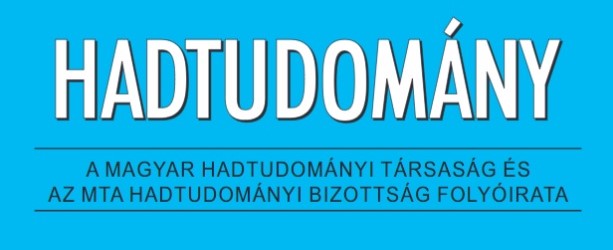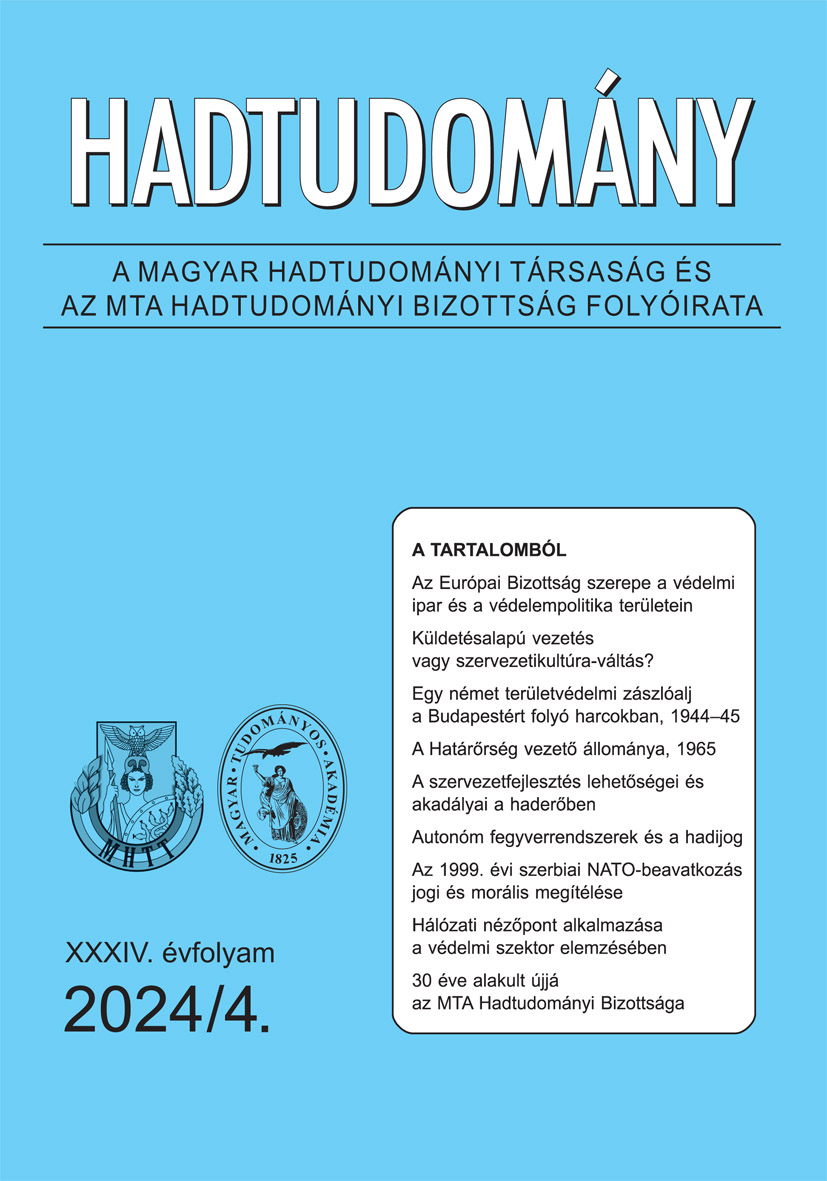The Appropriateness of Applying the Network Perspective in Economic Policy Decisions in the Case of Defence Industry
Abstract
There has long been a division of opinions among economic schools of thought as to what extent the state should (or should not) intervene in market and economic processes. The permissible extent also defines the limits and frameworks of the state’s economic role. The conclusion of this work is that the tasks of the state can be well modelled by applying the network perspective in the analysis of certain issues of economic policy and areas of the economy – such as the defence sector.
References
Acosta, Manuel; Coronado, Daniel; Marín, Rosario 2011. Potential Dual-Use of Military Technology: Does Citing Patents Shed Light on This Process? Defence and Peace Economics 22 (3): 335–349. https://doi.org/10.1080/10242694.2010.491681
Balogh Péter 2022. Patterns of Cooperation in the European Defence Sector – A Network-Approach-Based Investigation of EU Projects. Acta Univ. Sapientiae, European and Regional Studies, 22: 34–49. https://doi.org/10.2478/auseur-2022-0008
Barabási Albert-László 2022. Behálózva. A hálózatok új tudománya. Budapest: Open Books.
Benczes István; Kutasi Gábor 2010. Költségvetési pénzügyek. Budapest: Akadémiai Kiadó.
Bitzinger, Richard A. 2015. New ways of thinking about the global arms industry Dealing with ‘limited autarky’. Strategic Insights, ASPI, Australian Strategic Policy Institute https://www.aspi.org.au/report/new-ways-thinking-about-global-arms-industry-dealing-limited-autarky (Letöltve 2025. 01. 19.)
Boulanin, Vincent 2016. Mapping the innovation ecosystem driving the advance of autonomy in weapon systems. Working paper, Stockholm International Peace Research Institute https://www.sipri.org/sites/default/files/Mapping-innovation-ecosystem-driving-autonomy -in-weapon-systems.pdf (Letöltve 2025. 01. 19.)
Budavári Krisztina; Taksás Balázs; Hegedûs Ernő 2022. A magyar védelmi ipar innovációs környezetének vizsgálata. Hadtudomány, 32 (1): 113–134. https://doi.org/10.17047/HADTUD.2022.32.1.113
Calcara, Antonio 2020. Cooperation and non cooperation in European defence procurement. Journal of European Integration, 42 (6): 799–815. https://doi.org/10.1080/07036337.2019.1682567
Callado-Muñoz, Francisco J.; Fernández-Olmos, Marta; Ramírez-Alesón, Marisa; Utrero-González, Natalia 2022. Characterisation of Technological Collaborations and Evolution in the Spanish Defence Industry. Defence and Peace Economics, 33 (2): 219–238. https://doi.org/10.1080/10242694.2020.1799168
Coetzee, Wayne S. – Berndtsson, Joakim 2023. Understanding Sweden’s security economy. Defense & Security Analysis, 39 (2): 171-190. https://doi.org/10.1080/14751798.2023.2182479 Dinya László 2008. Szervezetek sikere és válsága. Budapest: Akadémiai Kiadó.
Dunne, J. Paul; Smith, Ron P.; Willenbockel, Dirk 2005. Models of Military Expanditure and Growth: A critical Review. Defence and Peace Economics, 16 (6): 449–461. https://doi.org/10.1080/10242690500167791
Dunne, J. Paul; Tian, Nan 2013. Military expenditure and economic growth: A survey. The Economics of Peace and Security Journal, 8 (1): 5–11. http://dx.doi.org/10.15355/epsj.8.1.5
Eliasson, Gunnar 2017. Visible costs and invisible benefits. Military procurement as innovation policy. Cham: Springer International Publishing AG.
Eliasson, Gunnar 2010. Advanced Public Procurement as Industrial Policy. The Aircraft Industry as a Technical University. New York: Springer Science+Business Media, LLC.
Etzkowitz, Henry: Innovation in Innovation: The Triple Helix of University – Industry - Government Relations. Social Science Information, 42 (3): 293–337. https://doi.org/10.1177/05390184030423002
Etzkowitz, Henry 2008. The Triple Helix. University–Industry–Government Innovation in Action. Taylor & Francis e-Library.
Farkas Beáta 2022. A közgazdasági gondolkodás rövid története. Budapest: Akadémiai Kiadó.
Gelei Andrea 2009. Hálózat – A globális gazdaság kvázi szervezete. Vezetéstudomány, 40 (1): 16–33. http://dx.doi.org/10.14267/VEZTUD.2009.01.02
Giacomello, Giampiero; Preka, Oltion 2023. Sources of strength: mapping the defence sector in Europe.
Defence Studies, 23 (4): 531–560. https://doi.org/10.1080/14702436.2023.2277436
Håkansson, Håkan 2010. Üzleti kapcsolatok és hálózatok: gazdaságpolitikai következtetések. In Håkansson, Håkan: Határtalan hálózatok. Budapest: Alinea Kiadó.
Harrison, Debbie; Håkansson, Håkan 2010. Hogyan mobilizáljuk az erőforrás-hálózatokat – légi és vízi kikötők összehasonlító elemzése. In Håkansson, Håkan: Határtalan hálózatok. Budapest: Alinea Kiadó.
Hartley, Keith 2006. Defence R&D: Data Issues. Defence and Peace Economics, 17 (3): 169–175. https://doi.org/10.1080/10242690600645027
Hayward, Keith 2001. The globalisation of defence industries. Survival, 43 (2): 115–132. https://doi.org/10.1093/survival/43.2.115
Lengyel Imre 2021. Regionális és városgazdaságtan. Szegedi Egyetemi Kiadó, Szeged.
Köves Alexandra; Mandják Tibor 2014. Úton egy fenntartható gazdasági paradigma felé – A komplexitás befogadása a hálózati elméleteken keresztül (Towards a sustainable economic paradigm – Acceptance of the complexity through network theories). Vezetéstudomány - Budapest Management Review, 45 (7–8): 69–75. https://unipub.lib.uni-corvinus.hu/1713/#:~:text=DOI%2010.14267/VEZTUD.2014.07.06
KSH 21.1.1.18. A kormányzat végső fogyasztási kiadása funkciók szerint [millió Ft] https://www.ksh.hu/stadat_files/gdp/hu/gdp0018.html (Letöltve 2025. 01. 19.)
Kurç, Çaðlar; G. Neuman, Stephanie G. 2017. Defence industries in the 21st century: a comparative analysis, Defence Studies, 17 (3): 219–227. https://doi.org/10.1080/14702436.2017.1350105
Mandják Tibor; Wimmer Ágnes; Juhász Péter 2012. A hálózati pozíció és a versenyképesség kapcsolata. (Business networks: network position and competitiveness in Hungary). Vezetéstudomány - Budapest Management Review, 42 (2): 14–23. http://dx.doi.org/10.14267/VEZTUD.2012.ksz2.02
Pesti István 2024. Védelmi ipari innovációs ökoszisztémák. Honvédségi Szemle – Hungarian Defence Review, 152 (3): 126–141. https://doi.org/10.35926/HSZ.2024.3.10
Riebe, Thea; Schmid, Stefka; Reuter, Christian 2021. Measuring Spillover Effects from Defense to Civilian Sectors –A Quantitative Approach Using LinkedIn. Defence and Peace Economics, 32 (7): 773–785. https://doi.org/10.1080/10242694.2020.1755787
Schmid, Jon 2018. The Diffusion of Military Technology. Defence and Peace Economics, 29 (6): 595–613. https://doi.org/10.1080/10242694.2017.1292203
Sempere, Carlos Martí 2018. What Is Known About Defence Research And Development Spill-Overs? Defence and Peace Economics, 29 (3): 225–246. https://doi.org/10.1080/10242694.2016.1239364
SIPRI Fact Sheet April 2024. Trend in world military expenditure, 2023 https://www.sipri.org/sites/default/files/2024-04/2404_fs_milex_2023.pdf (Letöltve: 2024. 05. 20.)
Szenes Zoltán 2022. A hadifinanszírozás napjainkban (1990–2020) In: Pósán, László; Veszprémy, László; Isaszegi, János (szerk.) A hadifinanszírozás gazdasági alapjai az ókortól napjainkig. Budapest: Zrínyi Kiadó.
Thadakamaila, Hari Prasad; Raghavan, Usha Nandini; Kumara, Soundar; Albert Réka 2004. Survivability of multiagent-based supply networks: a topological perspect. IEEE Intelligent Systems, 19 (5): 24–31. https://doi.org/10.1109/MIS.2004.49
The Defence Transfer Directive. Handbook for SMEs. European Union, 2021 https://defence-industry-space.ec.europa.eu/eu-defence-industry/defence-smes/defence-transfers-directive-handbook-smes_en (letöltve: 2024. 03. 24) Tirole, Jean 2021. Közgazdaságtan a közjóért. Budapest: Osiris Kiadó.
Vigvári András 2015. Pénzügy(rendszer)tan. Budapest: Akadémiai Kiadó.
Voszka Éva 2019. Iparpolitika határok nélkül = Industrial Policy Without Borders. Külgazdaság: A Kopint Konjuktúra Kutatási Alapítvány Folyóirata, 63 (1–2): 82–115. https://doi.org/10.47630/KULG.2019.63.1-2.82
Wiœniewski, Rafa³ 2012. Defence Industry in the European Union – Challenges and Opportunities in Times of Economic Crisis. Przegl¹d Strategiczny, (2): 95–113. https://doi.org/10.14746/ps.2012.2.8
Yildirim, Jülide; Sezgin, Selami; Öcal, Nadir 2005. Military Expenditure and Economic Growth in Middle Eastern Countries: A Dynamic Panel Data Analysis. Defence and Peace Economics 16 (4): 283–295. https://doi.org/10.1080/10242690500114751
Yildirim, Jülide; Öcal, Nadir 2016. Military Expenditure, Economic Growth and spatial spillovers. Defence and Peace Economics, 27 (1): 87–104. https://doi.org/10.1080/10242694.2014.960246
Zhang, Ying; Wang, Rui; Yao, Dongqi 2017. Does defence expenditure have a spillover effect on income inequality? A cross-regional analysis in China. Defence and Peace Economics, 28 (6): 731–749. https://doi.org/10.1080/10242694.2016.1245812




